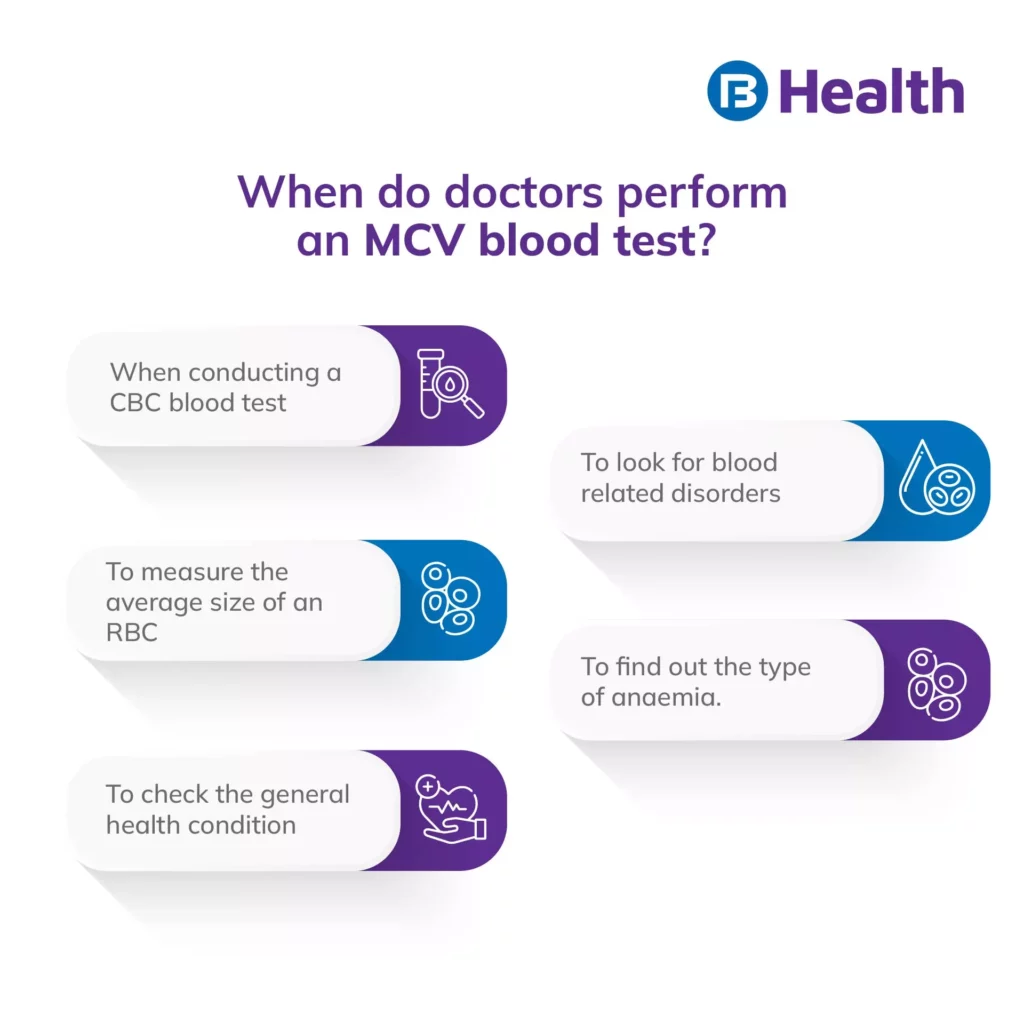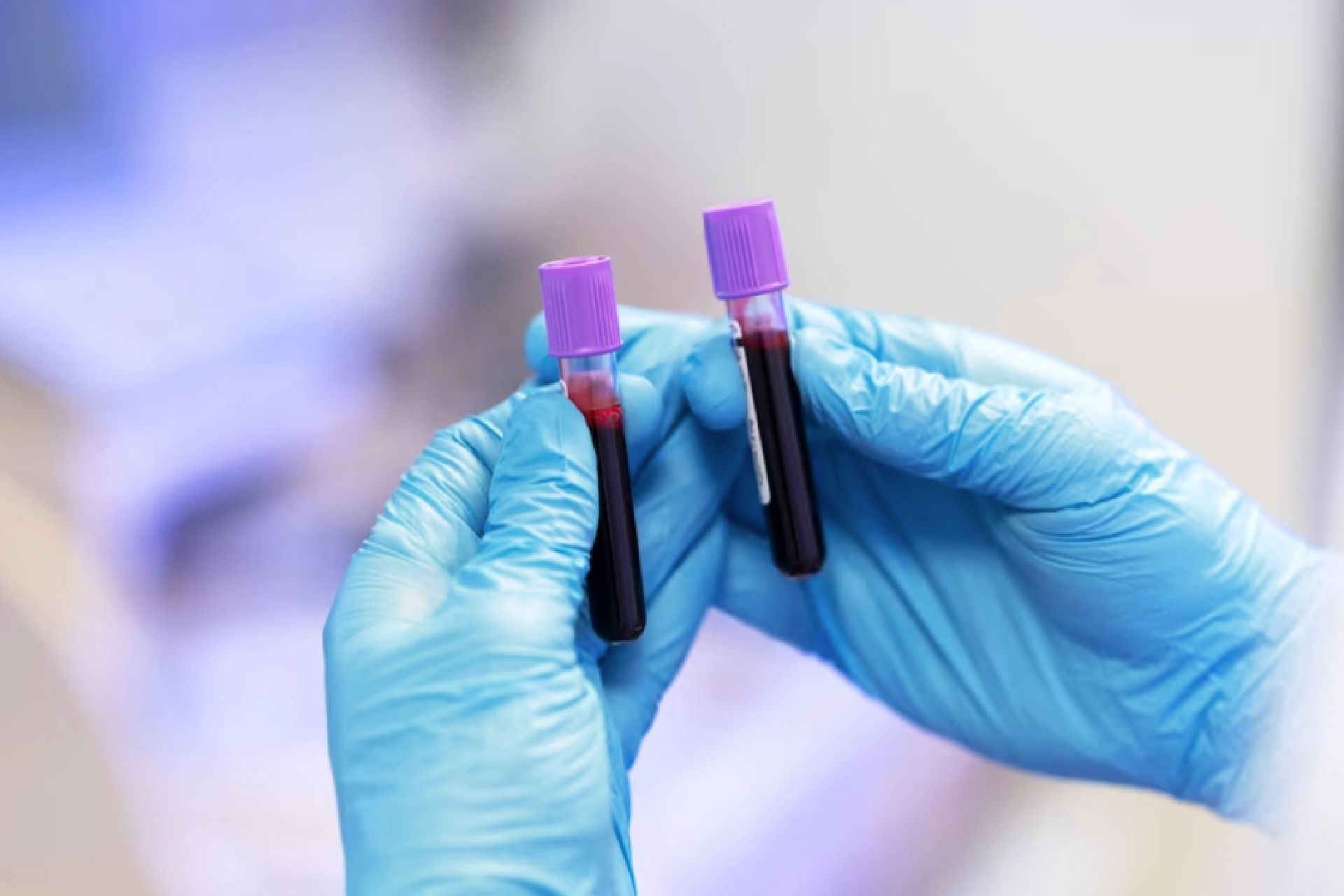Health Tests | 6 min read
MCV Blood Test: Purpose, Normal Range, Limitation
Medically reviewed by
Table of Content
Synopsis
A normal CBC procedure includes an MCV blood test. An MCV test will be used to confirm the kind of anaemia if a doctor suspects a patient has it. This blog discusses everything you need to know about an MCV blood test.
Key Takeaways
- Even if the MCV level is normal (80 - 100 fl), anaemia is still a possibility
- If a person's MCV levels are higher than 80 fl, they may develop microcytic anaemia
- If a person's MCV levels are higher than 100 fl, they may develop macrocytic anaemia
Mean corpuscular volume, or MCV blood test, is a test that measures the average count of your RBC (red blood cells). [1] It is a common blood test component termed a complete blood count (CBC). An MCV blood test, when combined with the findings of other tests, can assist your doctor in determining if you have anaemia, liver disease, or other problems.
What is MCV Blood Test?
MCV, or mean corpuscular volume, is a quantity determined by the blood test result. The RBC indices are a group of tests that assess certain aspects of RBC functionality, and the MCV blood test is one of them. The distribution of oxygen within the body can be impacted by variations in RBC volume, which may also indicate a blood problem or other medical issues.
How Does an MCV Blood Test Work?
A medical practitioner will use a tiny needle to collect blood from any vein in your arm during the MCV blood test. Following the insertion of the needle, a tiny amount of blood will be collected in a test tube or vial. You may feel a slight sting as the needle is inserted or removed. Generally, this only needs a few minutes.
Additional Read: Types of Blood Test
Purpose of MCV Test
A CBC includes many numbers, one of which is the mean corpuscular volume. Hence, each time a CBC is requested, healthcare professionals see the MCV. As part of standard screening tests, an MCV blood test may be requested. It may also be performed as part of diagnosing, treating, and monitoring various medical disorders.
While assessing symptoms or a health condition, a healthcare professional may sometimes choose to focus directly on the MCV blood test. Such examples are:
- To assess potential anaemia symptoms such as tiredness, pale skin, and lightheadedness
- To distinguish between various anaemia kinds
- To assess further blood abnormalities, such as an abnormal platelet or white blood cell count
- In many medical conditions as an extra test
- As a prognosis estimate in patients with certain medical issues
When Should I Have an MCV Blood Test?
If you exhibit anaemia-related symptoms, your doctor will request a CBC and closely compare the MCV to other tests, such as other RBC indices.
Among the early warning signs and symptoms of anaemia are:
- Consistently feeling weak or exhausted
- Hands and feet that are tingly and numb
- Appetite loss
- Becoming agitated
- Difficulties focusing or thinking
- Headaches
Other indications and symptoms that might appear as anaemia worsens include:
- The eye whites have a blue colour
- A desire to consume ice or other inedible items, such as dirt
- Pale skin tone
- Breathlessness during rest or light activity
- Mouth Ulcers
- Unsteadiness or lightheadedness after standing up
- An abnormally red or sore tongue
- Easily broken nails
- Unusual or more frequent menstrual bleeding
MCV Blood Test Normal Range
MCV blood test normal range in adults typically ranges from 80 to 100 femtoliters (fl). [2] Nevertheless, normal MCV levels differ across sexes and different age groups. The average outcomes from a 2022 analysis are as follows:
- The MCV of kids between the ages of 6 and 12 is typically 86 fl
People shouldn't be concerned if their reading is slightly above or below these ranges because MCV readings may vary between laboratories.
Additional Read: RDW blood test
Low MCV Blood Test Levels
There are certain illnesses that an MCV blood test low or high may indicate. Yet, you shouldn't base your concerns just on your MCV findings. While evaluating your health, your doctor will consider your symptoms, other test findings, and your MCV.
Microcytosis is defined as low MCV (less than 80 fl. It could indicate:
- Anaemia from iron deficiency
- Thalassemia
- Other problems with hemoglobin
High MCV Blood Test Levels
Microcytosis (high MCV) is defined as more than 100 fl. It could indicate:
- Chronic anaemia
- Vitamins B12 Deficiency
- A lack of folate
- Liver illness
- Dysfunction of the bone marrow, as in myelodysplastic syndrome
You could develop high MCV as a result of chemotherapy therapies.
MCV Blood Test Risk Factors
These blood tests are not regarded as dangerous. There may be some little bruising and discomfort at the time of the insertion of the needle, but these symptoms normally go away quickly.
Limitations of MCV Blood Test
Post-Transfusion
If a person has received blood transfusions, the MCV is of limited use. In this instance, the MCV would display the typical size of red blood cells from a transfusion and a person's own red blood cells. Thus, assessing the MCV before beginning a blood transfusion is important.
Mixed Anaemias
The MCV test will be less useful if a person has many types of anaemia. An individual's MCV could be normal, for instance, if they suffer from severe folic acid deficiency anaemia as well as severe iron deficiency anemia. That's because the first form of anaemia results in a low MCV, but the second type results in a high MCV, resulting in a generally normal reading.
False Positives
In some circumstances, the MCV could be mistakenly elevated. For example, when red blood cells clump, this can happen. In addition, it can occasionally occur in amyloidosis, paraproteinemia, multiple myeloma, and cold agglutinin disease. Moreover, it might occur when a person has extremely high blood sugar.Anaemia can be diagnosed if a person is constantly weary and constantly feels chilly. Individuals who have anaemic symptoms should see a doctor.MCV low means (less than 80 fl) a person is more prone to develop or has microcytic anaemia, elevating HbA1c Normal Range. They may develop macrocytic anaemia if their MCV levels are higher than 100 fl.
If you notice any anaemia signs, you should immediately seek medical care. You can book online lab test or opt for an online consultation with the doctors at Bajaj Finserv Health.
References
- https://www.testing.com/tests/mcv-test/
- https://www.ncbi.nlm.nih.gov/books/NBK545275/
Disclaimer
Please note that this article is solely meant for informational purposes and Bajaj Finserv Health Limited (“BFHL”) does not shoulder any responsibility of the views/advice/information expressed/given by the writer/reviewer/originator. This article should not be considered as a substitute for any medical advice, diagnosis or treatment. Always consult with your trusted physician/qualified healthcare professional to evaluate your medical condition. The above article has been reviewed by a qualified doctor and BFHL is not responsible for any damages for any information or services provided by any third party.



